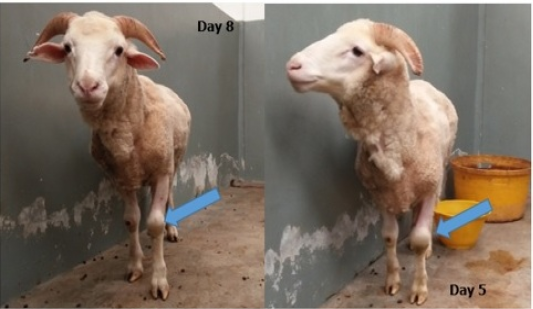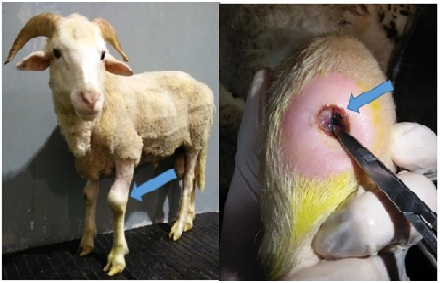Advances in Animal and Veterinary Sciences
Case Report
Clinical Management of Septic Arthritis in a Sheep: A Case Report
Faez Firdaus Abdullah Jesse1,3*, Asinamai Athliamai Bitrus2, Yusuf Abba2,4, Marlia Mahadzar1, Idris Umar Hambali1,4, Innocent Damudu Peter1,4 , Abd Wahid Haron1, Mohd Azmi Mohd Lila1, Abdul Aziz Saharee1
1Department of Veterinary Clinical Studies, Faculty of Veterinary Medicine, Universiti Putra Malaysia, 43400 Serdang, Selangor, Malaysia; 2Department of Veterinary Pathology and Microbiology, Faculty of Veterinary Medicine, Universiti Putra Malaysia, 43400 Serdang, Selangor, Malaysia; 3Institute of Tropical Agriculture and Food security, Universiti Putra Malaysia, 43400 Serdang, Selangor, Malaysia; 4Faculty of Veterinary Medicine, University of Maiduguri. P.M.B 1069 Maiduguri, Borno Nigeria.
Abstract | A 5-year-old male adult Merino sheep was presented to the Large Animal Unit, University Veterinary Hospital, UPM, with a complaint of inappetence and bilateral swelling of carpal joints. Clinical examination revealed that the sheep was dehydrated (7%), recumbent,pyrexic and has congested conjunctiva. The right carpal joint had a foul smelling wound (2cm x2cm) characterized by purulent exudates and maggots. The complete blood count (CBC) results revealed that the sheep had mild anemia with neutrophilic left shift and monocytosis whereas serum biochemistry revealed slight hyperbilirubinemia, hyperglobulinemia, hyperproteinemia and hypochloremia. From the history and clinical examination, the case was diagnosed as septic arthritis. Clinical treatment plan for this sheep were fluid therapy where 4L of Lactated Ringer’s solution together with 70 mL of dulphalyte was infused intravenously once. Wound cleaning at the joints were performed using povidone iodine daily for 10 days. Systemic antibiotic oxytetracycline (20mg/kg) was administered intramuscularly SID twice at 72 hours interval. Flunixin meglumine (1.1 mg/kg) as NSAID was administered intramuscularly TID for duration of 5 days whereas Dexamethasone (1mg/kg) as steroidal was administered intramuscularly SID twice at 72 hours interval. On the 8th day post treatment the prognosis of the case was good and the sheep was bright and alert with good appetite and the swelling at joints were resolved and the wound on the right carpal joint had healed. This case report highlights the clinical management of septic arthritis in a sheep.
Keywords | Clinical management, Septic arthritis, Carpal joint, Sheep, Veterinary medicine
Editor | Kuldeep Dhama, Indian Veterinary Research Institute, Uttar Pradesh, India.
Received | May 20, 2017; Accepted | June 23, 2017; Published | June 26, 2017
*Correspondence | Faez Firdaus Abdullah Jesse,Department of Veterinary Clinical Studies, Faculty of Veterinary Medicine, Universiti Putra Malaysia, 43400 Serdang, Selangor, Malaysia; Email: jesseariasamy@gmail.com
Citation | Jesse FFA, Bitrus AA, Abba Y. Mahadzar M, Hambali IU, Peter ID, Haron AW, Lila MAM, Saharee AA (2017). Clinical management of septic arthritis in a sheep: A case report. Adv. Anim. Vet. Sci. 5(6): 267-270.
DOI | http://dx.doi.org/10.17582/journal.aavs/2017/5.6.267.270
ISSN (Online) | 2307-8316; ISSN (Print) | 2309-3331
Copyright © 2017 Jesse et al. This is an open access article distributed under the Creative Commons Attribution License, which permits unrestricted use, distribution, and reproduction in any medium, provided the original work is properly cited.
INTRODUCTION
Septic arthritis is an inflammatory condition that is associated with the invasion of microbial pathogens into the joint space (Desrochers and Jean, 1996).The most common form of septic arthritis in small and large ruminants is bacterial arthritis. However, there are anecdotal reports of arthritis due to viral infections (Derochers and Francoz, 2014). One of the most damaging joint pathology is bacterial arthritis. Studies have reported that the origin of bacterial infections is from contamination, hematogenouse seeding, adjacent infection or direct trauma. In small ruminants, the distal joints are the most commonly affected by direct trauma (Mulon et al., 2016a). Other causes of septic arthritis could include iatrogenic infection which occurred as a result of intra-articular injection, this is however, rare in ruminants but more common in horses (Desrochers et al., 2001). The clinical presentation of animal with septic arthritis includes lameness, inappetence, pain, joint swelling, recumbency, muscle atrophy and reduction in growth rate (Desrochers and Jean, 1996).
In ruminants, septic arthritis is a common cause of lameness especially in cows. For instance, the incidence of lameness in a dairy herd due to arthritis was reported to be 13.8% (Mulon et al., 2016b). There is a paucity of information with regards to the significance of septic arthritis in ruminants. However, in American feedlots 12% of cases of lameness are associated with swollen, while in Israel, 13.8% of cases of lameness are linked with joint arthritis (Desrochers and Francoz, 2014). Septic arthritis is a welfare issue in ruminants and if not treated adequately, it can result to a prolonged severe pain, decreased joint function as well as decreased range of movement. Additionally, due to severe pain it may lead to alteration of the normal joint physiology that may contribute to a quick and permanent destruction of the joint cartilage and bone. Furthermore, in cases where synovial infections occur, the degradation of the synovial hemeostasis will lead to permanent damage to the cartilage as well as preventing complete healing of the joint (Mulon et al., 2016a).
Early diagnoses accompanied by prompt and effective treatment are essential to effectively manage the condition in order to restore the normal physiology of the joint. This prompt management of the clinical case may reduce the chances of culling the affected animals due to poor prognosis (Desrochers and Francoz, 2014). Diagnosis of the condition is normally based on clinical manifestation, analysis of the blood and synovial fluid as wells diagnostic imaging (Desrochers, and Francoz, 2014). For prevention, identifying the sources of infection is important in order to avoid clinical cases of septic arthritis in a farm (Mulon et al., 2016a). For medical management, administration of local and system antimicrobial agents and analgesic are recommended for mild and moderate clinical condition (Desrochers and Francoz, 2014). For severe and chronic clinical cases of arthritis surgical management is required or indicated (Desrochers and Francoz, 2014). Therefore the main aim of this clinical case report is to describe the clinical management of a clinical case of septic arthritis in a sheep.
Clinical Presentation
A 5 year old adult male Merino sheep was presented with the complaint of bilateral swelling of the carpal joint and inappetence (Figure 1). The sheep was semi-intensively raised farm and fed with Napier grass, pellets and supplement. Clinical examination revealed that the sheep was dehydrated (7%), recumbent, pyrexic (40.8 ºC) and with a congested conjunctiva. The right carpal joint has foul smelling wound (2cm x2cm) characterized by purulent exudates and maggots. Upon palpation of not at the affected joints, the sheep showed signs of discomfort and pain.
Laboratory Diagnosis and Sample Collection
Blood samples were collected in EDTA and plain blood tubes via jugular vein for complete blood count (CBC) and serum biochemistry analyses.The complete blood count (CBC) results revealed the sheep had mild anemia with neutrophilic left shift and monocytosis whereas serum biochemistry revealed slight hyperbilirubinemia, hyperglobulinemia, hyperproteinemia and hypochloremia (Table 1).
Table 1: Significant CBC and Biochemistry parameters of the septic arthritis sheep
|
|||||||||||||||||||||||||||||||||||||||
RBC= red blood cells; Hb= hemoglobin; PCV= packed cell volume;A:G=Albumin globulin ratio
Clinical Management and Treatment
From the history and clinical examination, the case was diagnosed as septic arthritis.Clinical treatment plans for this sheep were fluid therapy where 4L of Lactated Ringer’s solution together with 70 mL of dulphalyte was infused intravenously once to correct the dehydration status of the patient. Wound cleaning at the joints were performed daily for 10 days. The wound was thoroughly washed using normal saline together with povidone iodine and topical penicillin-streptomycin was applied BID for 10 days.Systemic antibiotic oxytetracycline (20mg/kg) was administered intramuscularly SID twice at 72 hours interval. Flunixin meglumine (1.1 mg/kg) as NSAID was administered intramuscularly TID for 5 days whereas Dexamethasone (1mg/kg) as steroidal anti-inflammatory was administered intramuscularly SID twice at 72 hours interval. The prognosis of the case was good. On the 8th day of post treatment and the sheep was bright and alert with good appetite and the swelling at joints were resolved and the wound on the right carpal joint had healed (Figure 2). For prevention, the owner was advised to have a good sanitary hygiene at the farm and pen of the sheep .

Figure 2: Showing gradual improvement of the bilateral carpal swelling at Day 5 and Day 8 post treatment
DISCUSSION
Lameness in ruminants, constitute one of the major economic drains of the livestock farming. It is one of the most common factors responsible for culling animals preceded only by failure in reproductive performance and mastitis (Coulon et al., 1996; Enting et al., 1997). Indirectly, lameness also causes significant economic losses through reduction in milk production, milk protein and milk fat as well as treatment cost (Enting et al., 1997; Seegers et al., 1998). Additionally, inappetence, severe pain and discomfort associated with septic arthritis induced lameness, leads to a reduction in carcass quality in livestock farms committed for meat production (Heppelmann et al., 2009). Septic arthritis in ruminants is a severe rheumatologic emergency as destruction of the joint tissues occurs immediately after the onset of infection and can lead to significant morbidity and mortality (Sharff et al., 2013).The condition have detrimental effect on reproductive capacities of the animals, thus resulting in severe economic loss. The common clinical manifestation of the condition are swelling and painful joints, lameness, inappetence and fever that takes place 2-5 days post onset of septic arthritis condition.This condition is also considered as major welfare problems in animals (Mulon et al., 2016a). For instance, this Merino Ram cannot be used to service other ewes in the herd due to the joint pain associated with septic arthritis.
To achieve effective and favourable outcome, there is the need for rapid onset of therapy. In addition, systemic application of analgesics and anti-inflammatory drugs also helps in achieving good and early onset of healing. Furthermore, the immediate initiation and administration of prolonged antibiotic treatment have shown to greatly improve the condition (Sharff et al., 2013) and it is in agreement with the therapeutic management of this case. In case of negative bacteriological cultures, it is important to administer broad spectrum antibiotics. However, the choice of the antibiotics used can be changed following sensitivity testing (Madison et al., 1991; Meijer et al., 2000). Furthermore, despite the rigors of intensive treatment, which in most cases involve repeated surgical interventions under anaesthesia, the outcome of the treatment is guarded. In this clinical case, the prognosis of the condition was observed to be promising following post treatment.Hence, the rationale behind opting for the treatment option used in the management of this condition as reported in this case report.
CONCLUSIONS
Septic arthritis is a medical emergency that requires prompt diagnosis and treatment in order to avoid morbidity, mortality as well as increasing the general welfare of the animal. In this case report, the sheep was presented with a classic case of septic arthritis. Hemato-biochemical changes showed anemia, neutrophilia and changes in serum biochemical parameters. Treatment with oxytetracycline, dexamethasone and funixine meglumine was able to reduce the inflammation and initiate healing.
ACKNOWLEDGMENTS
The authors wish to acknowledge the contributions of the staff of the University Veterinary Hospital, UPM.
CONFLICT OF INTEREST
The authors have no conflict of interest to declare.
AUTHOR’S Contribution
All authors were involved in the management of the case and proof reading of the manuscript.
REFERENCES






